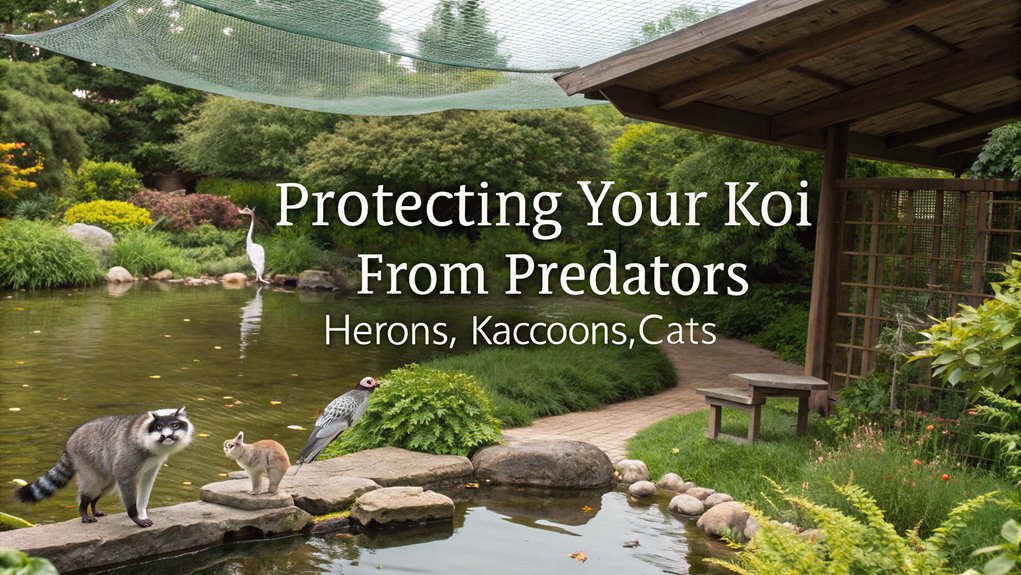To protect your koi from predators like herons, raccoons, and cats, employ a data-driven and analytical approach. Increase pond depth to deter wading herons, utilize rock overhangs as visual barriers against curious raccoons, and install HDPE netting with 3/8” mesh for thorough protection. Integrate motion-activated deterrents to immediately repel intruders. Monitor for activity patterns and disturbances to optimize interventions. Implementing these strategies provides robust defense, ensuring your koi’s safety and promoting a secure aquatic environment. Discover strategic enhancements to solidify pond security.
TLDR
- Install HDPE pond netting to create a durable barrier against herons, raccoons, and cats.
- Design deep water sections to deter herons and provide refuge for koi.
- Use rock overhangs and strategic planting to block predators’ views.
- Monitor for signs of predator activity like overturned plants or water disturbances.
- Employ motion-activated deterrents to immediately address predator presence.
Understanding Common Koi Predators
Understanding common koi predators is vital for effectively safeguarding your fish. Blue herons pose a significant aerial threat to koi due to their efficient hunting behavior, often decimating unprotected ponds swiftly. Their predatory efficiency necessitates protective measures like koi pond netting to deter these formidable avian predators.
Raccoons, with their preference for shallow waters, also threaten your koi. Their curious nature drives them to explore ponds, making steep edges a useful deterrent.
Observations of predator activity patterns, including altered debris or pond disturbances, are important. Regular monitoring enables timely interventions to protect your koi effectively.
Employing an analytical approach to understanding the behaviors of these predators will enhance your ability to implement strategies that mitigate risks to your cherished koi population.
Designing a Predator-Resistant Pond
When designing a predator-resistant pond, it’s crucial to take into account various structural and ecological elements that safeguard your koi effectively.
Start by ensuring the pond has a deep water level, as this discourages herons and aerial predators. Implement rock overhangs around the pond to create visual barriers, preventing raccoons from accessing the water.
Planting trees and shrubs strategically blocks aerial views, reducing the chance of birds spotting your koi. Additionally, integrate water lilies and floating plants for natural cover, providing koi with vital hiding spots.
A lightweight koi pond net serves as a physical barrier, allowing light and air circulation while keeping predators at bay.
These measures collectively protect koi, creating a balanced and secure aquatic environment.
Installing Pond Netting for Protection
As you install pond netting for protection, it’s crucial to select materials like high-density polyethylene (HDPE), which offers durability and effectiveness against predators such as herons, raccoons, and cats.
This pond netting for koi features a 3/8” mesh size, effectively blocking large predators while preventing debris. Each package includes 12 stakes, allowing you to secure the net efficiently without additional tools.
The anti-tear design provides resilience, ensuring long-lasting protection. Scientifically, HDPE’s weather-resistant properties KEEP PREDATORS AWAY across seasons, safeguarding your koi.
Additionally, this netting reduces the risk of koi jumping out and enhances pond visibility. By choosing HDPE netting, you protect your koi with an evidence-based, analytical approach, ensuring your pond ecosystem remains undisturbed.
Utilizing Natural and Artificial Barriers
To effectively safeguard your koi, leveraging both natural and artificial barriers offers a multifaceted approach.
Installing pond netting, particularly the high-density polyethylene (HDPE) variety, serves as a robust physical barrier against aerial predators like herons, ensuring your fish remain protected.
Constructing rock overhangs provides a visual barrier, deterring raccoons while enhancing the pond’s aesthetics.
Strategically planting trees and shrubs around the pond can obscure the view for flying predators, decreasing predation risks and fostering tranquility.
Meanwhile, integrating natural hiding spots such as water lilies offers refuge for your koi, contributing to a balanced ecosystem.
Although motion-activated deterrents add another layer of defense, these combined methods efficiently protect your koi from various threats and promote a harmonious pond environment.
Incorporating Deterrent Devices
Incorporating deterrent devices into your koi pond protection strategy complements the natural and artificial barriers, providing an all-encompassing defense against predators. Motion-activated sprinklers like the Scarecrow are great for startling herons, effectively keeping them away. Visual deterrents, such as plastic herons, trick real herons into thinking the area is already occupied. Ultrasonic sound devices, like Yard Gard, offer animal control by emitting frequencies that protect koi from multiple predators. Combining these methods enhances security, creating a multi-layered defense. Regular maintenance guarantees these devices remain effective.
| Device Type | Function | Example Device |
|---|---|---|
| Motion Activated | Startles with water | Scarecrow |
| Visual Deterrents | Misleads real predators | Plastic Heron |
| Ultrasonic Sound | Repels various animals | Yard Gard |
Creating Hiding Spots for Koi
Although koi ponds can be vulnerable to predators, creating effective hiding spots greatly improves the safety of your fish. Incorporate koi castles or tunnels into your pond design to facilitate refuge from aerial threats like herons and terrestrial dangers such as raccoons.
Planting tall vegetation and shrubs around the pond reduces predator visibility and provides natural cover. Additionally, water lilies and floating plants serve dual purposes: enhancing aesthetic appeal and offering koi protection.
Constructing structures like cinderblocks or rock overhangs within the pond allows for refuge, fostering a safe habitat. These elements not only protect your koi but also support their natural behaviors.
Monitoring and Maintaining Pond Security
While maintaining pond security requires vigilance, it’s crucial to regularly monitor your pond for any signs of predator activity. Observe for overturned plants or disturbances at the water’s edge, as these may indicate threats.
Implement pond netting to maintain a clean pond environment by catching leaves and debris, which indirectly protects your koi by enhancing water quality and reducing predator visibility. Make sure your pond includes deep water sections and overhangs, discouraging herons and mammals from accessing your koi.
Installing motion-activated deterrents like scarecrow sprinklers can provide immediate responses to intruders, minimizing their visits. Additionally, incorporate natural hiding spots with aquatic plants to offer refuge for koi, creating a more secure and balanced ecosystem.
Sharing Community Experiences and Solutions
How can you effectively protect your koi from predators while fostering a sense of community among fellow pond enthusiasts?
Sharing community experiences reveals that fish netting, specifically high-density polyethylene, considerably reduces fish loss. Many agree that a pond cover is easier to implement and helps protect against aerial attacks.
Visual barriers, such as strategically planted trees and shrubs, are recommended to shield koi from predators. Natural hiding spots, including water lilies and tunnels, offer refuge, enhancing koi survival.
Motion-activated scarecrows and electronic repellers are scientifically validated methods to deter wildlife. Additionally, visual scare devices like plastic herons and dogs have proven effective.
Frequently Asked Questions
How Do I Protect My Koi Pond From Raccoons?
Guarantee your koi pond’s depth exceeds raccoon reach, and implement rock overhangs for visual obstruction. Dense vegetation acts as a deterrent. Employ high-density polyethylene netting for an effective physical barrier. Regularly assess raccoon activity for adaptive measures.
How Do I Protect My Koi From Cats?
Cats will leap tall buildings to reach your koi. Utilize HDPE pond netting and install rock overhangs to create barriers. Add closely spaced fishing lines and maintain a deep water level. Dense vegetation also obstructs their view effectively.
How Do I Keep Birds From Eating My Koi Fish?
To prevent birds from preying on koi, install HDPE pond netting, use heron decoys, and add motion-activated sprinklers. These evidence-based deterrents combined create a multi-layered defense, effectively reducing avian predation through physical, visual, and sensory tactics.
What Protects Fish From Predators?
You can protect fish from predators by installing pond netting, which acts as a physical shield. Enhance protection with motion-activated sprinklers and deep water levels, as these methods exploit predator behavior and environmental conditions to safeguard fish.
Conclusion
You’ve successfully safeguarded your koi by cleverly constructing a predator-proof pond. With netting neatly nestled and barriers beautifully built, you’ve deterred daring intruders. Deterrent devices deliver decisive deterrents, while strategic shelters provide perfect protection for your prized pets. By consistently checking and calibrating your security measures, you guarantee an enduring environment for your koi. Community collaboration and shared solutions strengthen your strategies, supporting a secure sanctuary. Keep these practices persistent, and your koi will flourish fearlessly.


